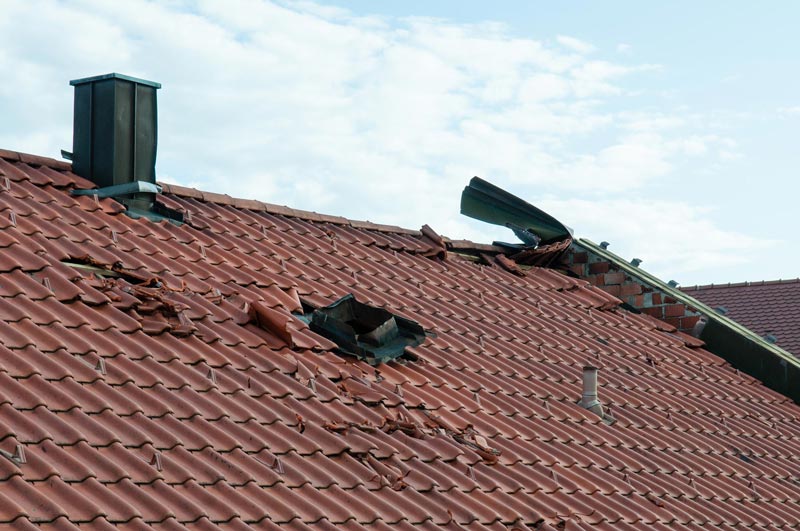You’ve got a beautiful home, but hail can wreak havoc on your roof. Don’t let Mother Nature have her way – it’s time to protect your investment.
In this guide, you’ll learn about detecting hail damage, maintaining your roof, choosing hail-resistant materials, and dealing with insurance. We’ll also discuss why and when you should schedule professional roof inspections.
Let’s make sure your roof stands up to the elements.
Understanding the Impact of Hail on Your Roof
You’ve got to understand the impact of Denver’s climate on your roof, especially that hailstorms can cause serious roof damage, impacting not just the surface, but the overall structure as well. When a hailstorm hits, those ice balls pummel your roof, creating dents and cracks. Imagine someone throwing rocks on your roof, that’s what hail does.
Over time, this damage can lead to serious problems. You might start to notice leaks, especially after it rains. The water can seep through the cracks, damaging your ceiling and walls. That’s not all, though. The insulation in your attic could get wet, which can lead to mold growth. You know what that means, right? Health problems for you and your family.
Now, you’re probably thinking, ‘But I’ve checked my roof after a hailstorm and it looked fine.’ Well, that’s the thing. You can’t always see the damage. It might be hidden, under the shingles or in the deeper layers of the roof. That’s why it’s important to get a professional inspection after a hailstorm. They’ll be able to spot the issues that you might’ve missed.
Key Indicators of Hail Damage on Roofs
Spotting hail damage on your roof can be tricky, but there are key indicators you should be aware of. The most common signs include dents or bruises on your shingles. These irregularities can be small and hard to spot, so you’ll need to inspect your roof closely. Sometimes, they may look like dark spots where the granules of the shingle have been knocked off.
Another indicator is a high amount of granules in your gutters or downspouts. As hail hits your roof, it can dislodge these small particles from your shingles. If you’re seeing a lot more granules than usual after a hailstorm, it’s likely that your roof has sustained damage.
You may also notice cracks or holes in your shingles. This kind of damage is usually more severe and requires immediate attention. If left unchecked, it can lead to leaks and further damage to your home.
Importance of Regular Roof Maintenance Against Hail
While anyone can experience hail damage, regular roof maintenance can significantly reduce the risk and the extent of the damage. You mustn’t underestimate the importance of upkeep. You see, hail can exploit any weak spots on your roof. An old roof, or a roof in poor condition, is more susceptible to severe damage during a hail storm. That’s why a regular maintenance plan is a smart investment.
In your plan, schedule inspections at least twice a year, ideally in spring and fall. These are great times to catch any minor issues before they become major problems. A professional roofer can spot potential vulnerabilities, such as loose or missing shingles, that could be devastating in a hail storm. They’ll also ensure your gutters are clean and functioning, which is crucial for proper water runoff.
Selecting Hail-Resistant Roofing Materials
Often, you’ll find that choosing hail-resistant materials for your roof is as crucial as regular maintenance, and it can significantly lower the chances of hail damage. It’s not just about going for the most expensive option, but understanding what works best in your region’s climate and weather conditions.
Start by researching different materials and their hail-resistant properties. Asphalt shingles, for instance, are known for their durability and resistance to hail. Metal roofs, on the other hand, are extremely durable and can withstand hail sizes up to 2 inches in diameter. Slate and tile roofs also offer excellent resistance, but they’re costlier and require more structural support.
Don’t forget to check for the UL 2218 classification, which indicates the material’s resistance to hail. Class 4 is the highest rating, meaning the material can resist 2-inch hailstones without damage.
Also, consider consulting with a local roofing professional. They’ll have a better understanding of what works best in your area and can guide you towards the most effective, cost-efficient materials.
Professional Roof Inspection: Why and When
By investing in a professional roof inspection, you’re not only ensuring the longevity of your roof, but you’re also taking an essential step in protecting your home from potential hail damage. Professional roof inspectors have the expertise to identify weak spots and potential problems that you might overlook. They’re trained to spot the subtle signs of damage that can result from hailstorms, such as dents, punctures, or granule loss on your shingles.
You might wonder when is the best time to get a professional roof inspection. Well, it’s recommended to have your roof inspected at least once a year, or after a major hailstorm. Regular inspections will catch minor issues before they escalate into costly repairs. After a major storm, an inspection can help assess the damage and estimate the repair costs.
Insurance Coverage for Hail Damage
You’ve got your roof inspected, and now you’re wondering about insurance coverage for hail damage, right? Well, you’re on the right track because most homeowner’s insurance policies do cover hail damage. However, it’s important to understand the specifics of your policy.
Typically, insurance companies classify hail damage under ‘Acts of God’. This means that they can’t penalize you for such claims. But remember, not all policies are created equal. Some may only cover your roof at its actual cash value, which considers depreciation. Others offer replacement cost coverage, paying the amount it costs to replace your roof with a new one, minus your deductible.
Another key thing to remember is that you need to act quickly. Most insurance companies require you to report hail damage within a certain timeframe. So, don’t sit on it. Once you’ve spotted damage, get in touch with your insurance company promptly.
Lastly, keep records. Document the damage with photos and keep a copy of all correspondence with your insurance company. This will help if there are any disputes about your claim. So, with a bit of knowledge and quick action, you can navigate the insurance process smoothly.
Essential Steps to Take After a Hailstorm
After a hailstorm has passed, it’s crucial that you inspect your roof for any potential damage, as this will set the stage for any necessary repairs or insurance claims. Don’t wait, as undetected damage can lead to severe issues down the line.
Start by visually inspecting your roof. Look for any signs of damage such as dents, cracks, or missing shingles. Use binoculars if it’s safe to do so. Remember, it’s always best to call a professional if you’re unsure or if the damage is extensive.
Next, check your gutters and downspouts. Hail can leave them clogged or damaged, which can cause water damage to your home. If you spot any issues, get them fixed immediately.
Afterward, document any damage you find. Take clear photos and notes of all affected areas. This will be vital when you’re filing an insurance claim.
Lastly, don’t forget to contact your insurance company as soon as possible. They’ll guide you through the process of filing a claim. If your claim is approved, they’ll cover the cost of repairs or replacement.
Frequently Asked Questions
What Are Some Common Misconceptions About Hail Damage on Roofs?
You might think hail damage is always visible or all hail causes damage. That’s not true. Sometimes, damage isn’t visible and small hail can still harm your roof. It’s not just about size.
Can Hail Damage Affect the Overall Structure of My House?
Absolutely, hail damage can impact your home’s overall structure. It’s not just your roof that’s vulnerable, but siding, windows, and gutters can also suffer. Regular inspections are crucial to catch and repair any damage early.
How Long Does It Typically Take for a Professional to Repair Hail Damage on a Roof?
The duration of repair depends on the extent of the damage. Typically, it can take a few days to a week. You’ll have a more accurate timeline once the professionals assess your roof’s condition.
What Type of Professional Should I Hire to Assess Potential Hail Damage on My Roof?
You should hire a licensed roofing contractor to assess potential hail damage on your roof. They’ve got the expertise to accurately diagnose issues and recommend necessary repairs. Don’t skimp on professional advice. It’s worth it.
Are There Any Preventative Measures I Can Take to Protect My Roof From Hail Damage Beyond Regular Maintenance and Choosing Resistant Materials?
Yes, beyond routine maintenance and resistant materials, you can install hail guards for HVAC units, and use protective shields for skylights. Regular tree trimming also reduces the risk of damage caused by falling branches.
Conclusion
In conclusion, protecting your roof from hail damage starts with understanding its impact and spotting key indicators. Regular maintenance, choosing hail-resistant materials, and obtaining professional inspections are crucial.
Don’t forget about insurance coverage, as it’s a lifesaver when a hailstorm hits. After any hailstorm, follow the essential steps to safeguard your home.
So, stay prepared and proactive. After all, your roof’s health is vital for your home’s protection.


